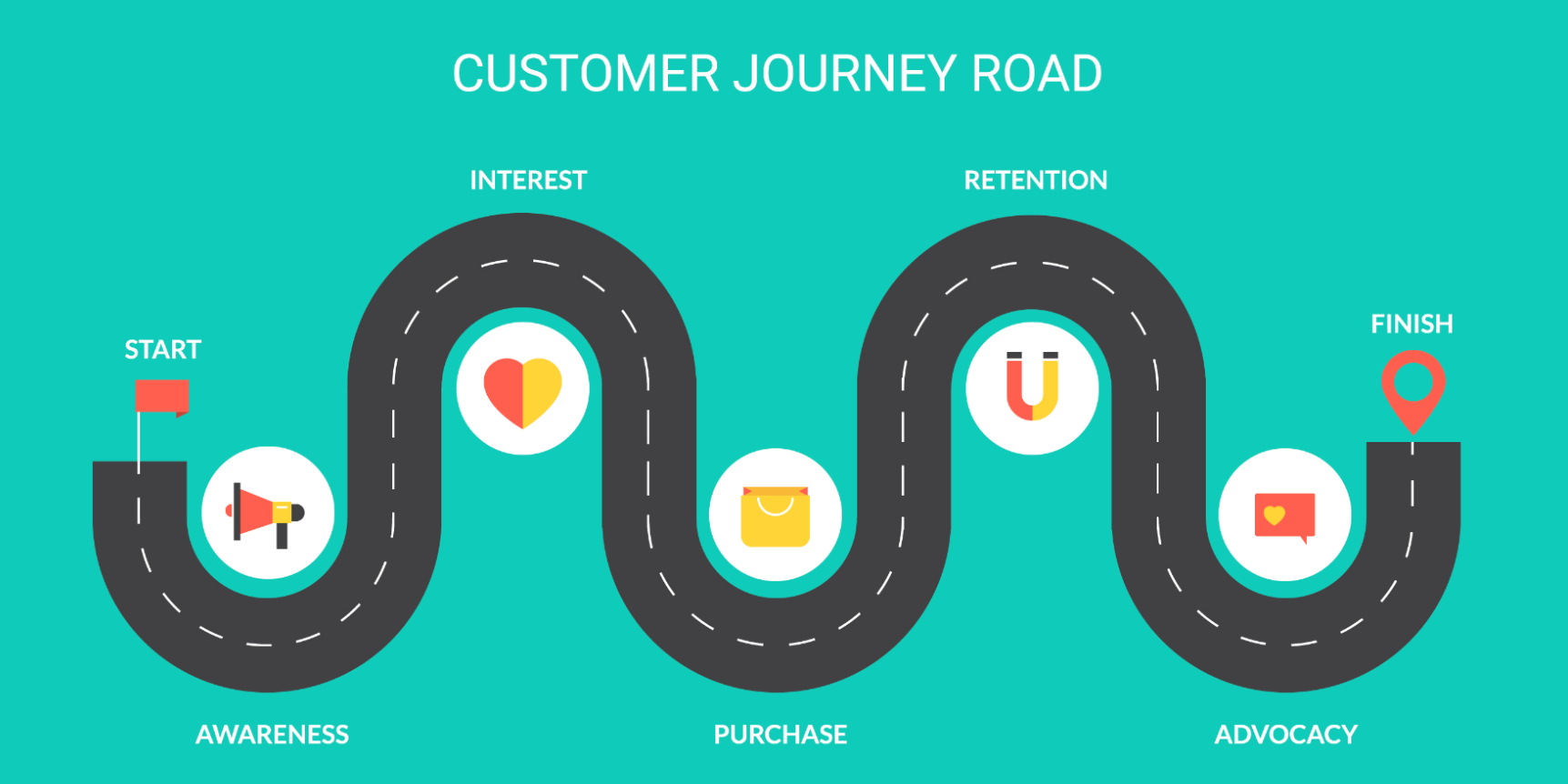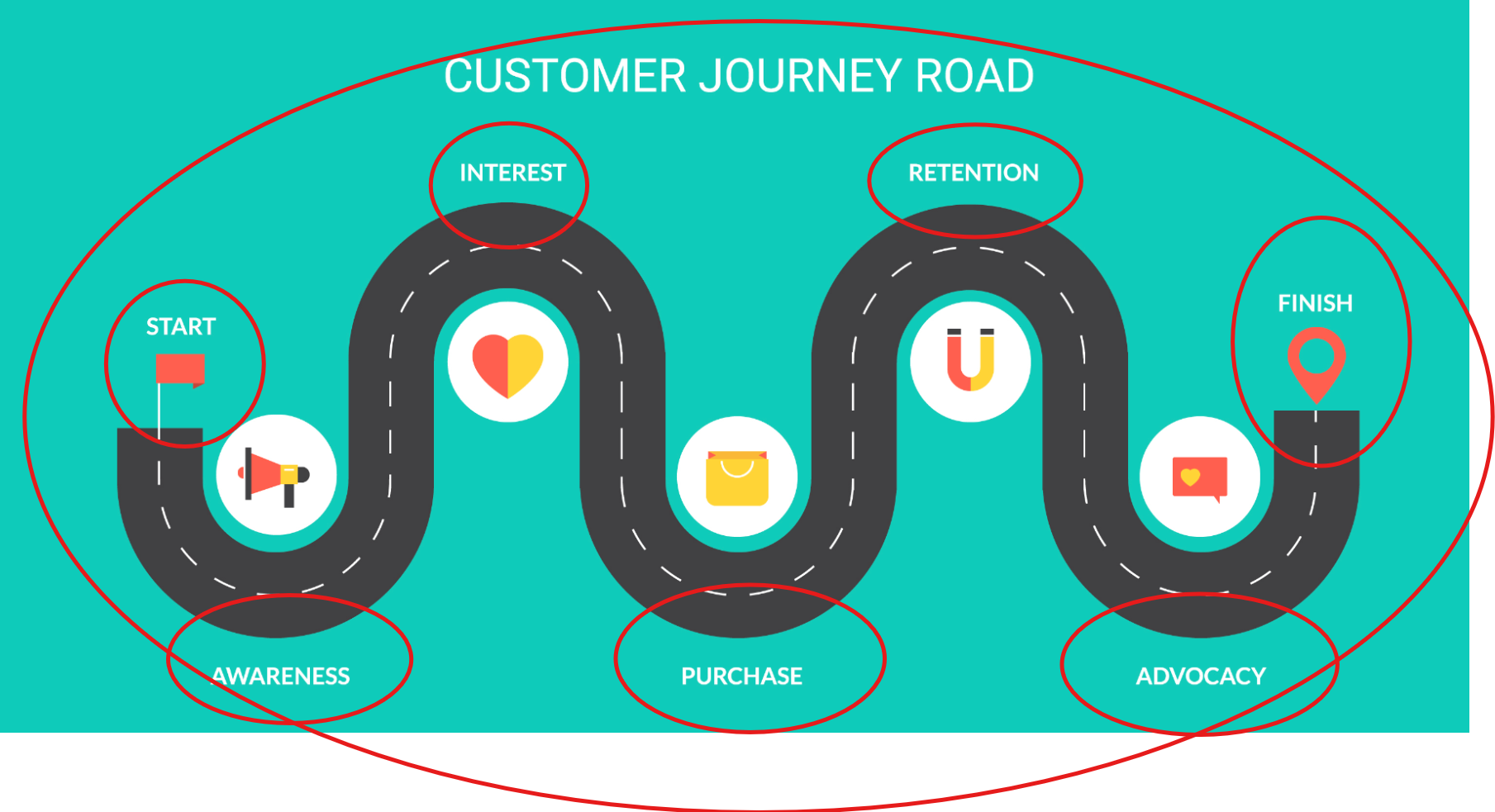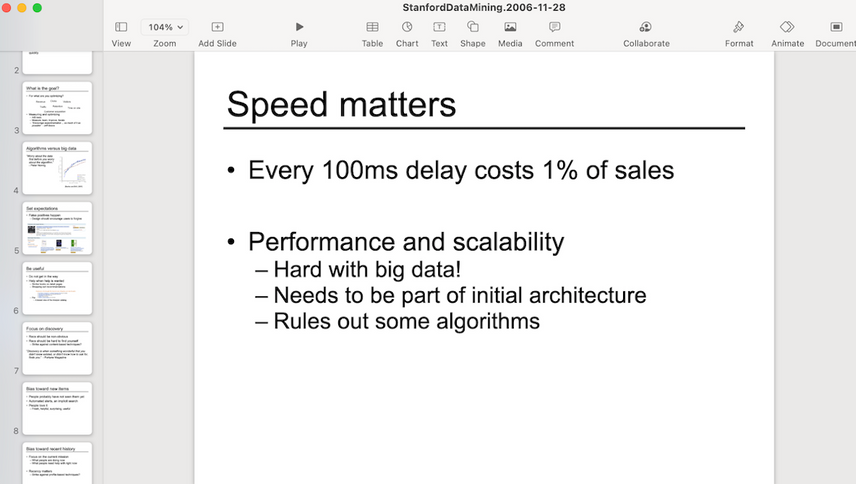Why Developers Should Care About Customer Journey Maps
How understanding the Customer Journey can help create better development roadmaps and products
Start typing to search...
How understanding the Customer Journey can help create better development roadmaps and products
Have you ever heard that before? In this day and age, it’s fortunately not super common but it is still prevalent sometimes. The truth is, everyone should care about the customer journey.
An efficient customer journey can directly impact business success, including retention rates, churn rates, upsell and much more. Yes, it is the responsibility of the Customer Experience (CX) team to craft and foster this journey, but everyone needs to be involved and aware of it. For developers, it’s helpful to remember that every line of code can impact how customers interact with your brand.
It can be helpful for everyone to remember the customer journey, and specifically use a Customer Journey Map to visualize this journey. I’ve written about this before, but for this article we are going to dive deeper into why developers in particular should care about this!

Customer Journey Maps (CJM) are a visualization of the experience that customers receive when they interact with your brand. It typically starts with their first touchpoint or even pre-first touchpoint and ends with renewals or support post-sale - though ideally it never ends and the customer is a repeat customer and goes through it all again!
These maps are a great way to identify pain points and opportunities for improvement for customers, but also internally. Speaking of internal moves, they are great tools for cross-functional teams to help move towards customer-centric goals together!
A well-defined CJM doesn’t just help CX teams—it helps developers understand the bigger picture. When development teams are aware of key touchpoints, they can build better infrastructure, optimize workflows, and preemptively fix issues before they create friction.

A customer journey map consists of multiple stages, each representing a different phase of interaction between the customer and the brand. These stages typically include awareness, consideration, purchase, retention, and advocacy. Some businesses may include additional phases depending on their industry or customer lifecycle.
At each stage, key touchpoints come into play. These are the moments when a customer interacts with the brand, such as visiting a website, browsing product pages, engaging with a chatbot, submitting a support ticket, or receiving a follow-up email. Each of these touchpoints influences the customer's experience and determines whether they continue moving through the journey or drop off due to friction.
A well-designed customer journey map does more than outline interactions—it also identifies pain points. These are areas where customers experience confusion, frustration, or barriers that prevent them from smoothly progressing through the journey. Addressing these pain points is crucial in creating a seamless, engaging experience that keeps customers coming back.
For example, in an e-commerce purchase, the journey may begin when a customer sees a Facebook ad promoting a product. If the ad is compelling, they click on it and land on the website, where they browse through product descriptions, read FAQs, and decide whether to make a purchase. If the website is well-structured and provides clear, relevant information, the customer is more likely to proceed. However, if they have unanswered questions, they may reach out to customer support via chat or email before adding items to their cart.
Once in the checkout process, the experience should be as seamless as possible, requiring minimal effort from the customer. A confusing or lengthy checkout process can lead to cart abandonment. However, if the experience is smooth, the customer completes the purchase, receives an order confirmation email, and awaits their product. If they require a refund, the process should be simple and intuitive, ideally handled through a self-service portal without unnecessary delays.
If the customer is satisfied with the purchase, they may return to buy again, subscribe to loyalty programs, or recommend the brand to friends. A well-optimized customer journey ensures that every interaction reinforces trust, satisfaction, and long-term engagement.
This is a simplified example of how an e-commerce journey unfolds. Each stage presents opportunities for optimization, from reducing friction in checkout to improving post-purchase engagement and customer retention strategies.
Whether they realize it or not, developers are key to a successful customer journey. They play a crucial role in shaping the digital experience by ensuring smooth functionality, optimizing performance, and eliminating friction points. Developers are responsible for creating and maintaining many digital touchpoints mapped in the customer journey. This includes website UX, app performance, payment systems, and more. Every interaction a customer has with a digital platform is, at its core, the result of a developer's work. Below is the same CJM as above, except I’ve circled everywhere where developers should be involved and contributing:

Yes, that’s right, everything is circled, and then some, as every step is where developers can be involved!
Whether a customer has a positive or negative experience throughout their journey often depends on the quality of the code behind the platform or service they are using. For example, let’s look at our e-commerce journey. A customer may first see a Facebook ad, which directs them to the company’s website. Once they arrive, they navigate through various elements, including branding, UX, layout, tables, interactive components, and site navigation.
If they decide to make a purchase, the process should be streamlined. The customer adds the product to their cart, reviews the product description, and proceeds to checkout. Here, the developer’s role becomes even more crucial. The checkout process should be fast and intuitive, ensuring customers aren't frustrated by unnecessary steps, slow loading times, or technical glitches. Shipping and order confirmation emails should also be automated and accurate, reinforcing trust in the brand.
For example, if a checkout page loads too slowly, it directly impacts the purchase stage of the customer journey. This leads to frustration and abandoned carts, which means lost revenue. I know personally that I’ve exited checkout flows simply because they took too long to load. There’s no reason for a customer to stay if they feel uncertain about the transaction process or experience delays.
Another key area where developers impact the customer journey is onboarding. If onboarding is complicated or requires excessive steps, customers will likely look for an easier alternative rather than struggle through the process. A difficult onboarding experience discourages long-term engagement and increases churn.
Developers can simplify this process by reducing unnecessary steps, ensuring a logical flow, and implementing clear guidance. Even something as simple as minimizing clicks, providing auto-fill options, or ensuring error messages are helpful can make a huge difference.
Beyond checkout and onboarding, error handling is another critical area. If a customer encounters a 403 or 404 error page, how that experience is handled can determine whether they stay or leave. Developers can customize these pages to align with the brand’s messaging, provide alternative navigation options, and prevent unnecessary frustration.
That said, if developers are not actively involved in customer journey mapping, businesses miss key opportunities for optimization. Technical teams often bring unique insights that can enhance the customer experience in ways non-technical teams might overlook. For example, performance enhancements, security improvements, and automation can all directly impact retention rates.
If developers are excluded from the customer journey conversation, businesses risk increased support tickets, higher churn, and negative customer experiences due to unresolved technical issues. Even if developers aren’t directly focused on revenue metrics, their work plays a significant role in customer satisfaction and retention.
From a business perspective, there must be alignment between code, CX strategies, and broader company goals. When development teams work closely with CX and business stakeholders, they can create frictionless, high-performing experiences that drive both customer success and business growth.
When developers are working on technical implementations, there are many areas where they can align their work with the customer journey. By integrating their efforts with customer needs, developers can ensure that technical decisions directly contribute to a smoother, more intuitive experience.
For example, they can use journey mapping to identify which features and touchpoints matter most to customers. One critical area is checkout performance. Developers should prioritize performance optimizations in checkout flows because this is a key moment where conversions happen. If customers experience delays or errors at this stage, it directly results in lost sales and frustration.
Beyond performance, developers can also proactively address friction points. The journey map highlights areas where users struggle, allowing developers to find solutions. For example, form validation improvements, better autofill capabilities, and optimized mobile navigation can significantly reduce customer frustration.

When the customer journey map is well-defined, it becomes easier for developers to pinpoint inefficiencies and determine whether solutions require backend optimizations, UI enhancements, or a combination of both.
Once changes are implemented, measuring their impact is crucial. Developers should track how redesigns or new features affect engagement, support ticket volume, and overall user satisfaction. For example, an improved chatbot or knowledge base can reduce the number of customer support inquiries, saving time and operational costs.
Cross-team collaboration is another essential benefit of customer journey mapping. By having a shared framework, developers, CX teams, designers, and product managers can sit down together to discuss pain points and align on solutions.
This ensures everyone is on the same page, working towards both business and customer success goals from start to finish. When technical teams actively participate in shaping the customer journey, they help create seamless experiences that drive satisfaction, retention, and revenue growth.
Enough talk; let’s go over some real-life examples that demonstrate just how valuable developer involvement in the customer journey map can be.
Let’s revisit our e-commerce example. We’ve discussed this before, but it’s worth emphasizing—if checkout is slow, customers will abandon their carts. They’ll be frustrated, and they won’t return.
Developers play a crucial role in preventing this. They can optimize page load times, ensure payment gateways function seamlessly, and design responsive layouts that work across all devices. These optimizations directly impact customer satisfaction and conversion rates.

Another example is SaaS onboarding. If the process is confusing or overly complex, customers will hesitate to move forward. A slow, technical onboarding experience that takes weeks or months to complete is a major barrier to adoption.
Developers can solve this by streamlining account creation, simplifying the UI, and improving error messaging in real-time. By reducing onboarding friction, they can increase user adoption and improve customer retention.
Finally, let’s talk about self-service tools. Many customers prefer solving issues on their own rather than reaching out to support. However, if self-service tools are poorly integrated, they fail to provide value.
For example, if a chatbot frequently misinterprets requests or provides incorrect answers, customers will become frustrated and leave. Developers can build a more functional, intuitive chatbot while also enhancing the help center experience.
These improvements not only enhance the customer journey but also reduce support ticket volume, saving businesses time and resources. By aligning self-service tools with customer preferences, developers help customers find solutions efficiently, improving overall satisfaction.
I'm not going to lie—there are mostly pros when it comes to involving developers in the customer journey map. However, for the sake of argument, let's go over some potential drawbacks as well.
One major benefit is better prioritization. When developers consider the customer journey, they can focus on building features that deliver the highest value to users. This includes improving checkout processes, refining error messages, optimizing onboarding flows, and addressing any friction points that impact customer experience.
Another advantage is enhanced collaboration. By working with CX, design, and product teams, developers gain a shared understanding of customer pain points and goals. When all teams are aligned, it prevents miscommunication and ensures that technical solutions truly support the broader customer experience strategy.
If developers operate in isolation, CX teams might struggle to communicate critical technical needs, leading to a fragmented, disjointed experience for customers. By integrating developers into the CJM process, businesses can create seamless, intuitive interactions.
Lastly, customer journey mapping helps drive better outcomes. When developers take CJMs into account, customer satisfaction improves, and support overhead decreases. With fewer technical frustrations, support teams can focus on high-value issues rather than troubleshooting preventable UX problems.
That said, there are some challenges to consider.
The first is time. Developers already have packed schedules, and reviewing a CJM adds another layer of work. Balancing development priorities with customer experience insights requires careful coordination.
Another challenge is complexity. While developers are used to working with technical diagrams, some CJMs can become overly detailed and difficult to translate into action. We've kept our examples simple, but in reality, these maps can branch out into multiple pathways, making it hard to pinpoint exactly what to prioritize.
Misalignment is another risk. If a CJM is outdated or inaccurate, developers might waste time fixing something that isn’t actually broken. For example, if a checkout process was previously flagged as a major pain point but has since been optimized, developers may still focus on it instead of other critical issues.
The good news? There are solutions for each of these challenges.
By approaching CJMs with a balance of strategy and practicality, developers can significantly enhance customer experiences without disrupting their existing workflows.
There are several common pitfalls when developers either fail to consider the customer journey map or misinterpret it.
Historically, customer journey maps have been seen as tools for CX, customer support, and customer success teams. While they are indeed critical for these areas, developers must also recognize their role in the customer journey.
In today's digital-first environment, developers play a direct role in shaping how customers interact with a product. A CJM should not be treated as something for CX teams alone—it should be a collaborative tool that aligns business goals with technical realities.
Another major issue occurs when developers are left out of the CJM creation process. If they are only brought in later, they may be forced to work within unrealistic expectations set by non-technical teams.
Developers should provide early input to ensure that technical feasibility is considered from the beginning. For example, CX teams may envision a dream-state customer journey, but some of those ideas might not be technically possible—or may require significant infrastructure changes that need long-term planning.
By collaborating from the outset, developers can help shape realistic, impactful improvements to the customer journey rather than being told to build something that cannot be executed efficiently.
There is also a risk of overcomplicating development tasks based on an overly detailed or unclear customer journey map.
For example, if a CJM highlights an issue in the checkout process, but doesn't specify whether the problem is due to payment processing, page load speed, or form validation, developers may waste time fixing the wrong thing. Greg Linden spoke on how every 100ms delay cost Amazon 1% of sales. But if a developer isn’t worried about speed and is focusing on something else, then 1% can add up quickly.

Similarly, if a CJM becomes too broad or ambitious, it can lead to unrealistic expectations. Developers may feel pressured to implement large-scale changes that are either unnecessary or too complex to complete within reasonable timeframes.
To prevent these challenges, developers and CX teams should work together to ensure the CJM is actionable, realistic, and continuously refined.
When implemented correctly, CJMs serve as powerful tools that help developers prioritize their work while aligning technical execution with customer needs.
In the tech field, just because something is developed once doesn't mean it's finished forever. Continuous testing and iteration are necessary to ensure that both internal systems and customer-facing experiences remain optimized.
Developers need to test the impact of customer journey maps (CJMs) on their implementations and use them as a baseline for measuring improvements. For example, A/B testing redesigned workflows based on CJM insights can reveal what optimizations truly enhance the user experience.
From there, refinement should be an ongoing process. Every new product, feature, or release should align with the customer journey map. If a new feature does not support the CJM in some way, that’s a sign of a potential misalignment between development and customer needs.
Throughout the development process, the CJM should serve as a key reference point, helping teams stay focused on customer pain points and experience gaps. Once a product or update goes live, the CJM should also be updated to reflect changes, ensuring that it remains an accurate representation of the customer experience.
To ensure that customer journey improvements are effective, developers should track key performance metrics such as:
If these metrics show no significant improvement, it’s a signal that further refinement is needed. Customer journey maps are not static—they should evolve alongside user behavior, technical advancements, and business objectives.
By consistently testing, refining, and improving based on real customer data, developers can ensure that their work has a meaningful impact on customer satisfaction and business growth.

Hopefully, by now, you can see that customer journey maps (CJMs) are not just for the CX team—they're for everyone. Developers, in particular, play a crucial role in turning CJMs into real, functional experiences.
CJMs are not just tools for understanding customer interactions; they are strategic assets for improving technical implementation and customer satisfaction. By leveraging them, developers can prioritize their work more effectively and gain a deeper understanding of how their contributions impact both users and business success.
The connection between a developer’s work and the broader customer journey cannot be overstated. Every feature, optimization, and bug fix influences how customers interact with a product or service. When developers align their work with CJMs, they help create seamless, frustration-free experiences that drive engagement, retention, and overall business growth.
To maximize this impact, collaboration is key. Developers should work closely with CX teams, designers, and product managers to ensure that technical decisions support the overall customer journey. CX teams, in turn, should actively involve developers in CJM discussions and planning.
By working together, teams can transform customer insights into tangible improvements, ensuring that the digital experience is not only functional but also intuitive, efficient, and enjoyable.